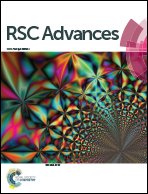Enhancing the photovoltaic performance of dye-sensitized solar cells by modifying TiO2 photoanodes with exfoliated graphene sheets
Abstract
Exfoliated graphene sheets (EGS) are obtained using simple liquid phase sonication and then mixed with TiO2 nanoparticles in a dye sensitized solar cell photoanode to achieve higher electrical conductivity and faster electron transfer due to much fewer defects as compared to conventional reduced graphene oxide (RGO): ID/IG of 0.256 in EGS as compared with that of 1.128 in RGO. The EGS–TiO2 photoanode yields a conversion efficiency of 8.24%, over a 19% increase compared with that of the RGO–TiO2 photoanode, and a 43% increase over that of TiO2 alone under the same conditions.


 Please wait while we load your content...
Please wait while we load your content...